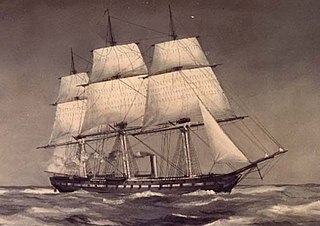USS New London was a screw steamer of the Union Navy during the American Civil War. She was outfitted with a Parrott rifle and 32-pounders, and was assigned as a gunboat in the Union blockade of the Confederate States of America.

USS Wabash was a steam screw frigate of the United States Navy that served during the American Civil War. She was based on the same plans as Colorado. Post-war she continued to serve her country in European operations and eventually served as a barracks ship in Boston, Massachusetts, and was sold in 1912.

USS Sciota was a Unadilla-class gunboat built on behalf of the United States Navy for service during the Civil War. She was outfitted as a gunboat, with both a 20-pounder rifle for horizontal firing, and two howitzers for shore bombardment, and assigned to the Union blockade of the waterways of the Confederate States of America.

USS Stars and Stripes was a 407-ton steamer acquired by the U.S. Navy and put to use by the Union during the American Civil War.

George Beall Balch was a Rear Admiral in the United States Navy who served during the Mexican–American War and the American Civil War.

USS Sagamore was a Unadilla-class gunboat built on behalf of the United States Navy for service during the American Civil War. She was outfitted as a gunboat and assigned to the Union blockade of the Confederate States of America. Sagamore was very active during the war, and served the Union both as a patrol ship and a bombardment vessel.
USS Potomska was a wooden screw steamer rigged as a three masted schooner purchased at New York City from H. Haldrege on 25 September 1861. She was commissioned at the New York Navy Yard on 20 December 1861.
USS Itasca was a Unadilla-class gunboat built for the U.S. Navy during the American Civil War. She was used by the Navy to patrol navigable waterways of the Confederacy to prevent the South from trading with other countries.

USS Winona was a Unadilla-class gunboat built for service with the Union Navy during the American Civil War. Winona was heavily armed, with large guns for duels at sea, and 24-pounder howitzers for shore bombardment. Winona saw significant action in the Gulf of Mexico and in the waterways of the Mississippi River and was fortunate to return home safely after the war for decommissioning.

USS Unadilla was a Unadilla-class gunboat built for service with the United States Navy during the American Civil War. She was the lead ship in her class.

USS Huron was a Unadilla-class gunboat built for the United States Navy during the American Civil War for blockage duty against the ports and rivers of the Confederate States of America.

USS Aries was an 820-ton iron screw steamer built at Sunderland, England, during 1861–1862, intended for employment as a blockade runner during the American Civil War. She was captured by Union Navy forces during the Union blockade of the Confederate States of America, and was commissioned as a Union gunboat. Aries was named for the constellation.
USS Isaac N. Seymour, also referred to variously as Seymour, I. N. Seymour and J. N. Seymour, was a steamer acquired by the Union Navy for use as a gunboat during the American Civil War. She was used by the Navy as a littoral ship in fire support, supply and blockading roles.

USS Isaac Smith was a screw steamer acquired by the United States Navy during the American Civil War. She was used by the Union Navy to patrol navigable waterways of the Confederate States of America to prevent the Confederacy from trading with other countries. In 1863, she became the only warship in the American Civil War to be captured by enemy land forces. She then served in the Confederate States Navy as CSS Stono until she was wrecked.

USS Tahoma was a Unadilla-class gunboat built by order of the United States Navy for service during the American Civil War.
USS Augusta Dinsmore was a steamer acquired by the Union Navy during the American Civil War. She was used by the Union Navy as a gunboat in support of the Union naval blockade of Confederate waterways. Because of her relatively large size, she was also sometimes used as a cargo ship.
The third USS Virginia was a 581-ton blockade-running steamer captured by the United States Navy and put to use during the American Civil War. Virginia served the U.S. Navy primarily as a mortar gunboat. Her ordnance included six 24-pounder howitzers and a 12-pounder rifled gun.

Battery White was an artillery battery constructed by the Confederates during the American Civil War. Built in 1862–63 to defend Winyah Bay on the South Carolina coast, the battery was strongly situated and constructed; however, it was inadequately manned, and was captured without resistance during the final months of the war.

John Cummings Howell was an officer in the United States Navy during the American Civil War. He rose to the rank of rear admiral and late in his career was commander-in-chief of the North Atlantic Squadron and then of the European Squadron.













